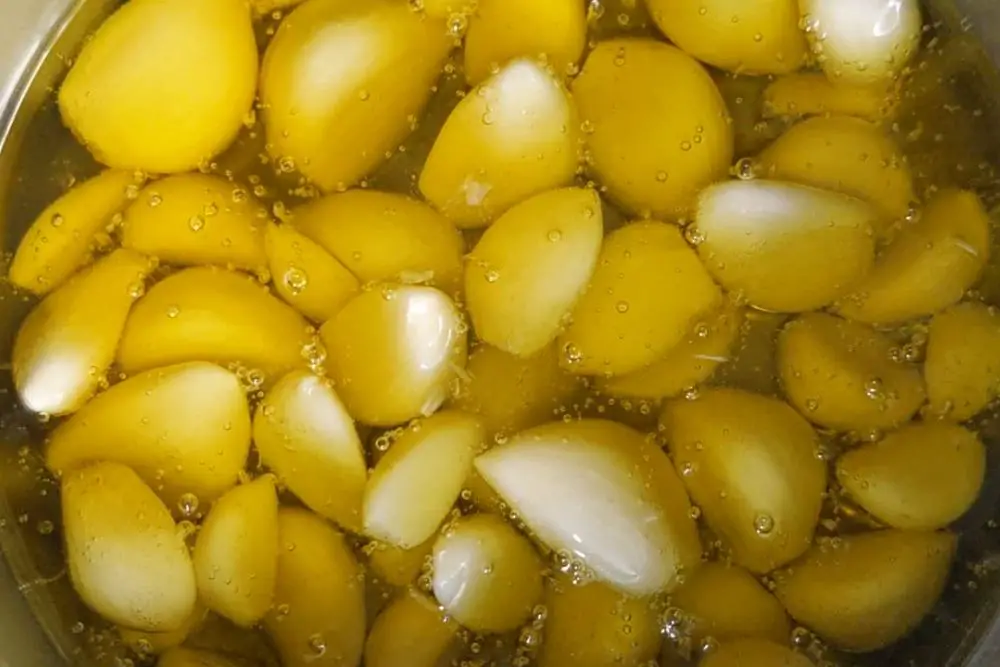Is It Dangerous to Use Raw Garlic in Sous Vide? Are There Other Options?
Is it safe to use raw garlic in sous vide? What to do instead if you have concerns about botulism? Let’s address them once and for all.

There have been a lot of discussions about whether or not it’s safe to use raw garlic in sous vide cooking.
Some say no, you should absolutely not put raw garlic in a vacuum bag for sous vide because it’s a perfect environment for botulism to grow, and you’ll get seriously ill.
Some say leaving raw garlic out of sous vide is an excess of precaution. You’ve got a better chance of choking and dying from your sous vide meal than you do from garlic botulism.
It’s quite a controversial topic, isn’t it?
In this article, I am going to humbly tackle it and share how I use garlic when cooking sous vide. I hope it addresses your concerns (if any) once and for all.
The Science of Garlic Flavor
We use garlic in our cooking for good taste. There’s no doubt about that.
Some like the sharp and pungent flavor of raw garlic. Others like the complex sweetness of roasted/cooked garlic with their food.
To better understand if it’s a good idea to use raw garlic in sous vide cooking, it’s necessary to look at how the flavors in garlic work first. Bear with me as I nerd out on the science behind it.
The garlic flavor comes from a chemical called allicin. Oddly enough, it’s not directly found in garlic cloves. Allicin forms from the reaction of two other chemicals, alliin, and the enzyme alliinase. These chemicals are found in different parts of the microscopic cells of garlic. The act of chopping, mincing, or crushing raw garlic is what allows the two chemicals to come together, react, and form allicin, which gives the garlic its flavor. As a result, the strength of garlic’s flavor depends on how you cut it.
Through traditional cooking methods, raw garlic hits comparatively high heat, and a series of chemical reactions start to occur between the enzyme amylase and the natural starch in garlic. The starch breaks down into simple sugars. When the sugars are released, all the key components of garlic undergo the Maillard reaction, which is one of the most delicious chemical reactions in food.

Simply put, the Maillard reaction is what causes any food to brown, a process that involves heat, water, sugar, and proteins. If you’d like to learn more about this specific reaction, here’s a good introduction. (Nerd away, just remember to come back!) We can thank the Maillard reaction for producing the deliciously complex sweetness in roasted/cooked garlic.
Since the Maillard reaction typically occurs at temperatures between about 230°F to 329°F (110°C to 165°C), and sous vide cooking is a low-temperature cooking method, now the question is, will sous vide cooking promote the taste of garlic and enhance the overall flavor of your food at all? Read on.
Does Raw Garlic in Sous Vide Make Your Food Taste Good?
It depends on the sous vide cooking time.
Based on my experiences, long hours of sous vide cooking not only softens whole garlic cloves just like roasting would but also effectively releases allicin. Therefore, you do get the benefits of adding raw garlic in your sous vide bag as if you were cooking it in a more traditional way.
I used raw garlic cloves Sous Vide Pork Adobo cooked at 176°F (80°C) for 7 hours and a generous amount of minced garlic in Honey Dijon Sous Vide Pork Shoulder cooked at 158°F (70°C) for 24 hours. The garlic worked perfectly well in both sous vide recipes due to the long hours of cooking. Especially with the pork adobo, the raw garlic cloves don’t just contribute to the entire flavor of the dish—vice versa, the meat and the adobo sauce infused the garlic so much that it almost felt like a sin not to eat the garlic cloves straight after cooking.
However, most of the time, raw garlic doesn’t actually get cooked in sous vide due to the low temperature. For example, if you add whole garlic cloves in a steak bag to sous vide at 129°F (54°C) for 1-1.5 hours, the garlic will still be raw after cooking. If you are expecting that complex sweet garlic flavor and the soft texture as part of the dish, you’ll be disappointed. If sharp raw garlic flavor is what you are looking for, then, by all means, use it in sous vide.
Now, I know what you are thinking—botulism!
Is It Safe to Use Raw Garlic in Sous Vide?
Botulism is caused by a toxin that’s made by Clostridium botulinum, AKA C. botulinum, which is a spore-forming bacterium. It is common in soil and other everyday substances, including garlic.
Under certain conditions, botulinum spores can grow and make one of the most lethal toxins known. Two of the conditions in which the spores can grow and make toxins are a low-oxygen or no-oxygen environment and within a certain temperature range. That puts a big red flag on sous vide cooking due to vacuum sealing and low-temperature cooking since it’s so close to creating a perfect place to reproduce the spores.
Note that Clostridium botulinum dies at around 126°F (52°C). But we don’t go lower than 131°F (55°C) most of the time when we sous vide. And if we do, for example, sous vide salmon at 122°F (50°C) or tuna at 110°F (43°C), just don’t add raw garlic to the sous vide bag. Any long-time cooking we do will most likely be above that and completely safe.
However, if you don’t consume sous vide food right away after cooking, how you store the finished products matters. The best practice for handling sous vide food is to chill it quickly in an ice bath and then refrigerate it or freeze it to minimize the time it spends in the danger zone where the bacteria can reproduce.
In a nutshell, as long as proper food handling and storage practices are in place, it’s not dangerous to vacuum-seal foods with raw garlic for sous vide.
If you want to take extra precautions, though, here are a few good ways of adding garlic to your sous vide foods that eliminate the concern about botulism altogether. I use these alternatives for flavor advantages more than anything.
Five Ways of Adding Garlic to Sous Vide Foods
1. Cook garlic in olive oil before adding it to a sous vide bag.

This is by far my favorite and most frequent way of using garlic in my sous vide foods. The garlic no longer gets the spotlight in this case, but the garlic-infused oil does!
My theory is that you are most likely going to add oil to your sous vide bag before cooking anyway. Why not use garlic-infused oil to enhance the flavor? Plus, if you want a bit more intensity, you can throw a couple of the cooked garlic cloves in the bag without worrying about botulism.
This method comes really handy when you are about to sous vide a bunch of vegetables.
Here’s how to do it.
- In a small saucepan, add peeled garlic cloves and cover with olive oil. Bring to a slow simmer over medium-low heat, about 10-15 minutes, or until the garlic starts getting wrinkly. Set aside and let it cool to room temperature.
- Prepare your meat or vegetables for sous vide, and add the garlic-infused oil along with a couple of the cooked garlic cloves to your sous vide bags before sealing them.
Depending on how much food you’ll be cooking, you can adjust the garlic and oil amount accordingly. I usually use at least one bulb of garlic to make the infused oil for sous vide, but it could be as few as two to four cloves.
2. Use garlic when pre-searing meat.

For some fatty cuts of meat, you’d want to pre-sear it to render the fat as well as lock in the flavor of whatever seasonings you use on it. Pre-searing is the perfect time to add raw garlic for taste, in my opinion. The garlic gets cooked and browned in a traditional way before adding it to sous vide. It’s sort of having the benefits of both worlds. I applied this method in my Sous Vide Lamb Chops. It works wonders!
3. Blend raw garlic into a marinade with salt.
As I mentioned before, the act of chopping, mincing, or crushing raw garlic is what allows the alliin and the enzyme alliinase to come together, react, and form allicin, the garlic flavor. To maximize the effect, I sometimes blend raw garlic with other ingredients and condiments into a marinade for my meat. A perfect example would be how everything comes together with the Red-Braised Sous Vide Pork Belly.
Keep in mind that salt and acid will make a really hard environment for botulinum spores to grow. So add salt and/or vinegar to your marinades for sous vide meat to minimize your concern.
4. Use store-bought jarred garlic or garlic powder.
A trick that some people have found to sous vide with garlic is using store-bought jarred garlic or garlic powder, which is treated to kill the botulism spores, supposedly.
5. Use garlic after cooking sous vide in the finishing steps.

Last but not least, you can introduce garlic after sous vide cooking in one of the finishing steps.
- Post sous vide, especially for meat, add garlic when searing your food. (For example, Sous Vide Duck Breasts.)
- Make a pan sauce with garlic to level up your meat dish.
- Incorporate garlic in a salsa or a topping to complete your meal.
Conclusion
On the surface, it might first appear that sous vide cooks without oxygen and at temperatures that could create the perfect environment for Clostridium botulinum to reproduce. One thing to note is that although botulinum spores multiply in a certain low-temperature range that generally matches the normal danger zone in cooking, they die around 126°F (52.2°C), and most of the time, we sous vide above 131°F (55°C). So, from a safety perspective, as long as you follow good food safety practices, your food shouldn’t be in this range long enough to have any risk of botulism.
Furthermore, pasteurization (bacterial death) is a function of both temperature and time. If you have high heat, you may only need it for seconds to kill all the bacteria. If you have a lower but sufficient heat like your sous vide bath, then as long as you cook your food long enough, you can still pasteurize it. This is why sous vide is magical because it cooks food for hours and not only produces magnificent taste and desired texture but pasteurizes your food at the same time.
And if you’d like to take extra precautions, refer to the five ways I mentioned above to add garlic to your sous vide dishes.
I hope this addresses your concerns about preparing food sous vide and botulism from garlic. I am curious: how do you add garlic to sous vide? Let’s discuss it in the comments below.
About the Author
Sharon Chen is an Integrative Nutrition Health Coach and author of the Complete Sous Vide Cookbook. She believes food not only brings healing but also connection. As the creator of StreetSmart Kitchen, she aims to make meal prep easier than ever and help you find balance, ease, joy, and simplicity in the kitchen as you improve your well-being.



